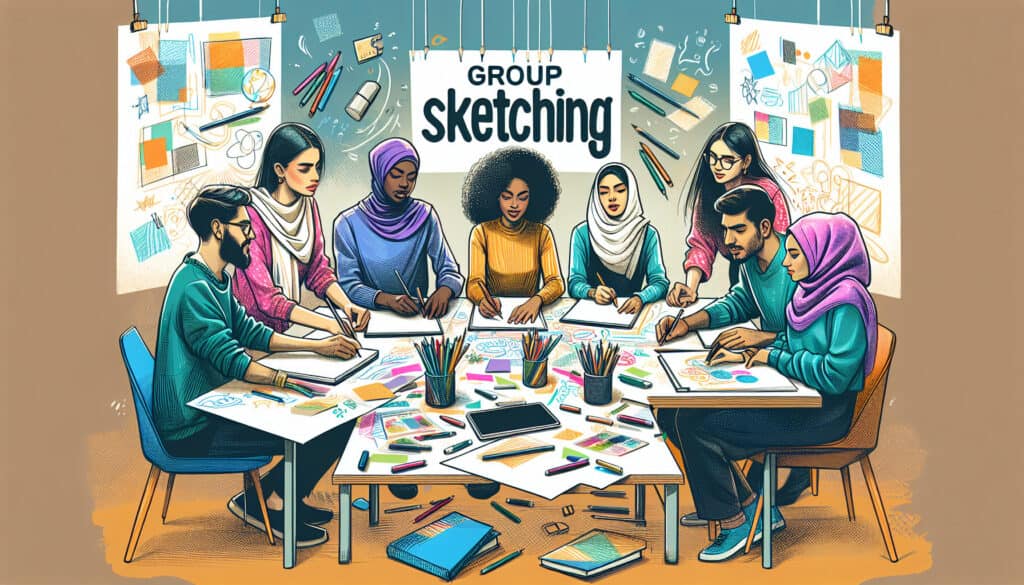A collaborative ideation technique that uses sketching to generate and explore ideas.
- Méthodologies : Économie, Lean Sigma, Fabrication, Résolution de problèmes, Qualité
Group Sketching

Group Sketching
- Remue-méninges, Créativité, Pensée conceptuelle, Idéation, Conception d'interaction, Prototypage, Travail d'équipe, User-Centered Design, Conception visuelle
Objectif :
Comment il est utilisé :
- A workshop activity where a group of people sketch out their ideas on a shared surface. It is a visual and interactive way to brainstorm and develop concepts.
Avantages
- Encourages collaboration and visual thinking; Can generate a wide range of ideas quickly.
Inconvénients
- Can be intimidating for people who are not confident in their drawing skills; May not be suitable for all types of problems.
Catégories :
- Idéation, Conception de Produits
Idéal pour :
- Brainstorming and developing concepts for a new product or service with a design team.
Group Sketching serves as an effective methodology in various phases of product development, especially during the ideation stage where teams seek to visualize concepts collaboratively. This approach is prevalent in industries such as consumer electronics, automotive design, and healthcare innovation, where creative input from diverse disciplines can enhance solutions. Typically initiated by designers, project managers, or innovation leads, this activity can involve cross-functional teams including engineers, marketers, and user experience researchers. Participants s'engager actively in sketching on a shared surface, which can range from digital whiteboards to physical flip charts, allowing for immediate visualization of ideas. Such interactive sessions not only accelerate idea generation but also lead to unexpected connections and richer dialogue among team members. This method is particularly beneficial when tackling ambiguous problems, as the visual nature of the sketches can help crystallize thoughts that might otherwise remain theoretical. Moreover, Group Sketching can be adapted for remote teams using digital platforms, ensuring that geographical barriers do not impede creative collaboration. This methodology can integrate elements of design thinking and agile practices, enabling iterative refinement of concepts as they evolve through feedback loops within the group.
Principales étapes de cette méthodologie
- Define the problem or challenge to address during the session.
- Provide materials such as markers, large paper, or digital tools for sketching.
- Set a time limit for each sketching phase to maintain momentum.
- Encourage each participant to sketch their individual ideas on the shared surface.
- After the individual sketching, invite participants to walk around and annotate each other's sketches.
- Facilitate group discussions to elaborate on and combine ideas from the sketches.
- Prioritize the most promising concepts for further exploration or refinement.
Conseils de pro
- Establish clear goals and guidelines for the session to maintain focus and direction in the brainstorming effort.
- Encourage the use of visual hierarchies in sketches to prioritize ideas and streamline discussions on their feasibility.
- Incorporate rapid iterations by allocating short timeframes for sketching, fostering spontaneous creativity and diverse perspectives.
Lire et comparer plusieurs méthodologies, nous recommandons le
> Référentiel méthodologique étendu <
ainsi que plus de 400 autres méthodologies.
Vos commentaires sur cette méthodologie ou des informations supplémentaires sont les bienvenus sur le site web de la Commission européenne. section des commentaires ci-dessous ↓ , ainsi que toute idée ou lien en rapport avec l'ingénierie.
Contexte historique
1949
1950
1950
1960
1960
1960
1960
1940
1950
1950
1958
1960
1960
1960
1960
(si la date est inconnue ou n'est pas pertinente, par exemple "mécanique des fluides", une estimation arrondie de son émergence notable est fournie)















Articles Similaires
Gestion des opérations de fabrication (MOM)
Système d'exécution de la fabrication (MES)
Plan de contrôle de la fabrication
Tests manuels
Tableaux d'évaluation des manutentions manuelles (MAC)
ManTRA (outil d'évaluation des risques liés aux tâches manuelles)